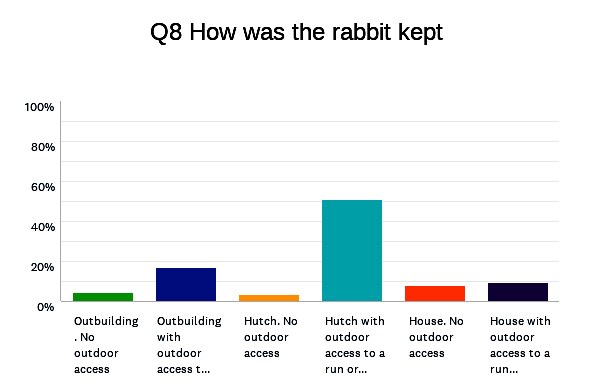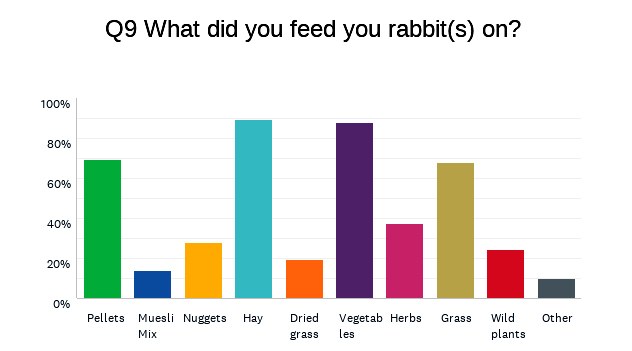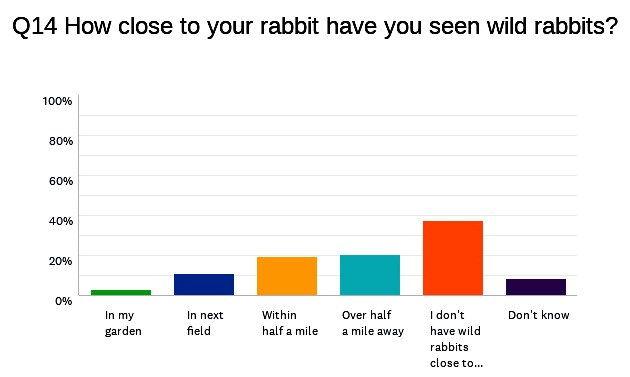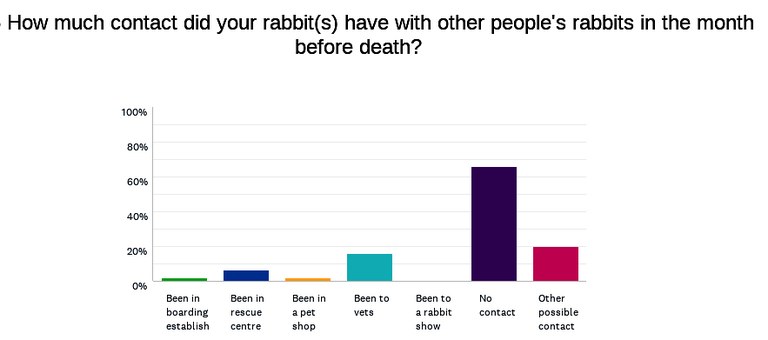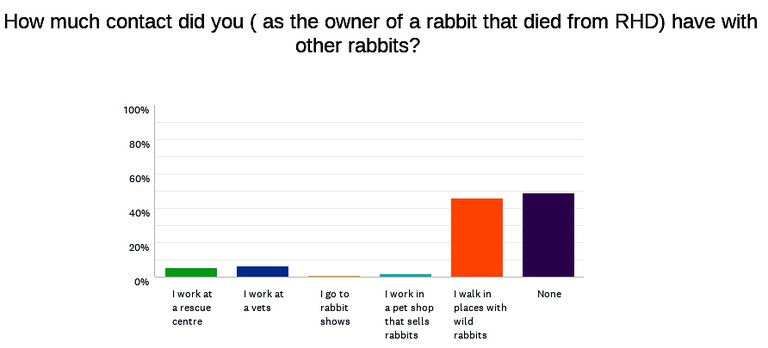Results of survey: Origin of RHDV outbreaks in pet rabbits
This was a survey for owners of rabbits that had died from RHD. It began in 2017 and ran for 3 years. There were 181 responses. The survey is now closed.
Aim of the survey
The aim of the survey was to try to work out the source of infection for rabbits that were dying from RHDV2 during an epidemic in UK pet rabbits. Owners were asked about:
- How many of their rabbits had died with RHD.
- How the disease was diagnosed.
- How the rabbits were kept and whether they had outdoor access.
- What were the rabbits that died fed on and which supermarket and brand of food did they use.
- How close they were to wild rabbits.
- How much contact there was between the rabbit, or its owner, with other rabbits through boarding kennels, pet shops, rescue centres, vets, shows etc. or walking through areas where wild rabbits live?
- Where they believed the infection came from.
Problems with the survey
There are inherent problems with online surveys. Sometimes people will fill them in twice or start them and not complete them. It is hard to prevent people from giving false answers although I do not believe this happened in this survey. Designing surveys is not easy and in retrospect, the design of this one could have been better. There were problems:
- There were only 181 responses. A bigger number would have given more significant results.
- One response was from someone who hadn’t lost any rabbits to RHD.
- There was only the option to record details of a single rabbit. Some owners gave details of several rabbits in the same record, so which rabbit did the information apply to?
Results
Despite the problems with the survey, there were some interesting results:
Number of outbreaks: 180 (174 in UK, two in Germany and one in Canada, Malta, Sweden and the Netherlands).
Confirmed as RHD: by histology (3) and/or PCR testing (71).
Presumed to be RHD from multiple deaths and/or clinical signs: 106
- 27 cases where diagnosis was made by owner ( the rabbits were unvaccinated in 26 of these outbreaks).
- 35 cases where diagnosis was made by vet from clinical signs.
- 44 cases where diagnosis was made by a vet who performed a post-mortem examination but didn’t send samples off for histology or PCR testing.
Results from confirmed cases
RHDV1 or RHDV2
Of the 71 cases that were PCR tested, 70 were RHDV2. The case of RHDV1 was historic. This result suggests that RHDV2 has superseded RHDV1 as the causative virus. Many publications have shown that this is a worldwide phenomenon. It explains the lack of efficacy of Nobivac Myxo-RHD in protecting rabbits against RHD.
Results from all confirmed and presumed cases
Breeding rabbits or pets?
150 of the outbreaks occurred in pet rabbits, 15 in breeding establishments and 11 in rescue centres.
Number of deaths in each outbreak
The number of deaths ranged from a single rabbit that lived alone (3) to losses of over 200. Multiple deaths were recorded in 140 cases although it was not evident if the rabbits died over a period of days, weeks, months or years.
Outdoor access
The graph shows that more rabbits with outdoor access died in comparison with rabbits no outdoor access. This finding could be interpreted that rabbits with outdoor access are at greater risk or it may be a reflection the way in which pet rabbits are kept nowadays.
Diet
In this question, respondents could choose a selection of options from the list so the graph shows a wide variation in the diet of pet rabbits. The majority of the rabbits that died were on a ‘good diet’ i.e. with hay, grass, vegetables, and forage featuring heavily. This finding is encouraging.
No link can be seen between the type of diet and the incidence of RHD. Hay, grass, vegetables and forage are all foods that could be contaminated by faeces of crow, foxes or other scavengers. Only one outbreak occurred in rabbits that were fed on pellets only.
Owners obtained food for their rabbits from a variety of sources. No particular brand of food or supermarket chain stood out from the rest.
Contact with wild rabbits
Some owners commented that although they had not seen any wild rabbits near their home, they lived in areas where wild rabbits would live. However, approximately half the respondents said there were no wild rabbits nearby.
Contact with other rabbits
The graph shows that most outbreaks occurred in rabbits had no contact with other rabbits in the week before they died. This suggests that infection is brought in by other means, such as food or owners. There were a number of rabbits had been in places where there could easily be infected rabbits e.g. rescue centres or veterinary practices.
Owner’s contact with other rabbits
Again, rescue centres and veterinary premises featured in these results. The most interesting finding was the number of owners that went walking in places where there are wild rabbits. The ‘other’ responses were mostly to say that the owner had no contact with other rabbits.
Owners, opinion on the source of infection
The last question asked where the owners believed the infection with RHD came from. Just over half the respondents (93/180) identified the source of infection as a rescue centre, veterinary premises, rabbit show, walking in areas where wild rabbits graze, garden wildlife, wild rabbits, forage or hay. One respondent blamed the vaccine and another (in Canada) believed the infection was deliberately introduced. The remaining 87 respondents said they had no idea where the infection came from but examination of their answers to previous questions often revealed a possible source of infection. In 21/87 cases, the owner, the rabbit that died or its companion had been to a rescue centre, veterinary practice or a show within a week of death. In 41/87 cases, the owners walked in places where there were wild rabbits or there were wild rabbits near their home. In another 24/87 cases, the rabbit grazed in the garden or the owner picked grass for their rabbit. In the remaining 3 cases where there was no obvious source of infection, two were outbreaks in indoor farmed rabbits. These occurred outside the UK. There was only a single case in UK where there was no obvious source of infection. This was a rabbit that lived in a hutch with outdoor access (but no grazing) and no wild rabbits close by. The diagnosis was confirmed by PCR testing.
Conclusions:
No firm conclusions can be drawn from the survey, but the results are indicative of some risk factors for outbreaks of RHD. These are:
- Outdoor access.
- Owners walking in areas visited by wild rabbits.
- Visits to vets or rescue centres.
The role of forage or hay as a source of infection was not clear from this survey.
All these risks can be overcome by having your rabbits vaccinated against RHDV1 and RHDV2

